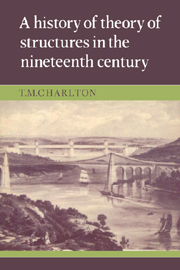Book contents
- Frontmatter
- Contents
- Preface
- 1 Introduction
- 2 Beam systems
- 3 Theory of the arch and suspension bridge
- 4 Elementary theory of frameworks: graphical statics
- 5 Theory of statically-indeterminate frameworks: the reciprocal theorem
- 6 Levy's theory of frameworks and bridge girders
- 7 Early developments of energy principles relating to theory of structures
- 8 The later development and use of energy principles
- 9 Applications of the least work principle: elastic theory of suspension bridges
- 10 Aspects of the further development of theory of structures
- 11 Secondary effects in structures
- Appendices
- Bibliography
- Name index
- Subject index
- Frontmatter
- Contents
- Preface
- 1 Introduction
- 2 Beam systems
- 3 Theory of the arch and suspension bridge
- 4 Elementary theory of frameworks: graphical statics
- 5 Theory of statically-indeterminate frameworks: the reciprocal theorem
- 6 Levy's theory of frameworks and bridge girders
- 7 Early developments of energy principles relating to theory of structures
- 8 The later development and use of energy principles
- 9 Applications of the least work principle: elastic theory of suspension bridges
- 10 Aspects of the further development of theory of structures
- 11 Secondary effects in structures
- Appendices
- Bibliography
- Name index
- Subject index
Summary
The objective of this work is to provide an account, with appropriate detail, of some of the salient features of the development of the theory and analysis of engineering structures during the nineteenth century. There seemed to be two possible approaches to the subject: that whereby emphasis is on personalities and their contributions to the subject, or that whereby emphasis is primarily on subject development, with due acknowledgement of personalities and regard to the chronological aspect. Experience indicates that the former is conducive to some degree of repetition and confusion concerning the subject matter and, therefore, the latter approach is adopted (though personal names are used in subheadings to identify developments). But Chapter 6 is unique in being devoted to Levy's little-known, though highly-significant work on theory of frameworks. Free translation of original material is used extensively throughout the book in order to avoid misrepresentation or serious omission. Also, original notation for mathematical analyses are preserved as far as possible.
Chapters 4 and 11 differ from the others in being little more than brief reviews of topics which, though important, are peripheral to my purpose herein. The former embraces graphical analysis of simple frameworks which, together with the vast subject of graphical analysis of engineering problems generally, has very limited relevance to the features with which this work is concerned and which have determined the development of modern theory of structures.
- Type
- Chapter
- Information
- A History of the Theory of Structures in the Nineteenth Century , pp. vii - viiiPublisher: Cambridge University PressPrint publication year: 1982

